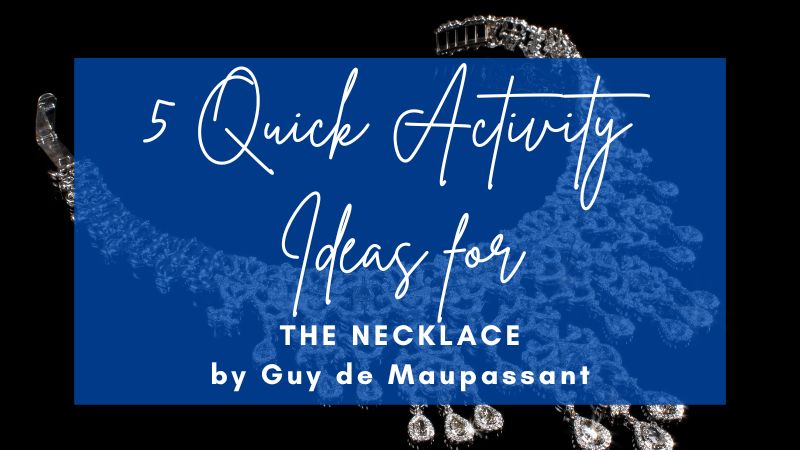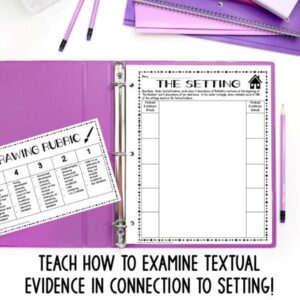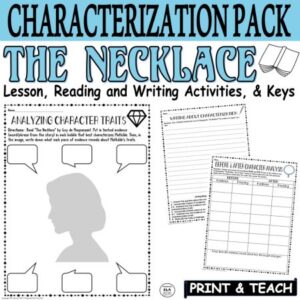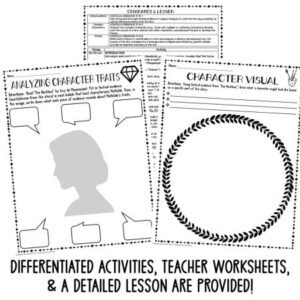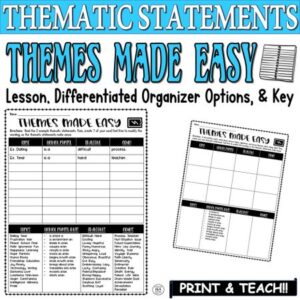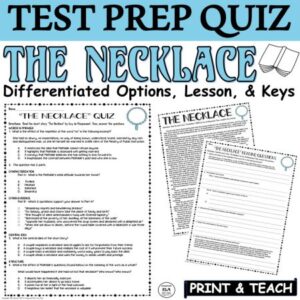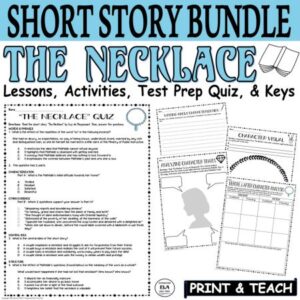The Necklace story by Guy de Maupassant is a staple in most middle and/or high school English classrooms. It is a classic piece of literature for many reasons. This story of riches to rags and letting go of one’s pride provides such a marvelous twist at the end, making this short story a must-teach!
Keep reading for “5 Quick Activity Ideas for The Necklace Story by Guy de Maupassant!”
Need help with teaching what reading strategies will work while using Test Prep? Check out this FREE Pack of 3 Test Prep Activities to help students achieve success on standardized tests!
5 Quick Activity Ideas for The Necklace Story by Guy de Maupassant
1. Writing Summaries
I know. I know. Writing a summary seems super basic; however, I would argue that very few people can summarize a piece of literature well. It takes several skills to be able to write a good summary!
Students MUST be able to do the following:
- Determine the main idea and/or theme of the story.
- Identify textual evidence/details to support the main/central idea.
- Write concisely with focused ideas.
This process can be tough for most students, which is why I usually start with chunking and writing 1-sentence summaries!
Check out this PDF option to see the story broken up into 9 chunks. Then, follow this process step by step:
- Read the first chunk. Locate evidence 2-3 pieces of textual evidence or more if you like. Model how to write a 1-sentence summary for this chunk only.
- Read the second chunk with your students. Let students help in locating evidence. Work with students to write a 1-sentence summary for chunk two.
- Read the third chunk with your students. Encourage students to work together in pairs to locate evidence and write a 1-sentence summary for the third chunk. Then, student pairs can share their examples or write their summaries on the board.
- Read the fourth chunk with your students. Give students the opportunity to underline/highlight as they read for textual evidence and write a 1-sentence summary independently or in pairs/groups.
- And so on…you get the drift!
Depending on your students, you can differentiate by requiring a certain amount of evidence, reading as a whole class or independently, letting students work individually, in pairs, or in small groups, etc.
Before you begin any analysis activities, you may want to teach summarizing!
2. Examine Setting
The setting plays a significant role in the story from start to finish. So choosing to focus on the setting is a good place to begin teaching The Necklace Story by Guy de Maupassant!
Setting is the description of the time and place. Let’s look at the setting from the beginning of this story:
Mathilde suffered ceaselessly, feeling herself born to enjoy all delicacies and all luxuries. She was distressed at the poverty of her dwelling, at the bareness of the walls, at the shabby chairs, the ugliness of the curtains. All those things, of which another woman of her rank would never even have been conscious, tortured her and made her angry. The sight of the little Breton peasant who did her humble housework aroused in her despairing regrets and bewildering dreams.
She thought of silent antechambers hung with Oriental tapestry, illumined by tall bronze candelabra, and of two great footmen in knee breeches who sleep in the big armchairs, made drowsy by the oppressive heat of the stove. She thought of long reception halls hung with ancient silk, of the dainty cabinets containing priceless curiosities and of the little coquettish perfumed reception rooms made for chatting at five o’clock with intimate friends, with men famous and sought after, whom all women envy and whose attention they all desire.
SETTING DESCRIPTION OF HER REAL HOME:
- “poverty of her dwelling”
- “bareness of the walls”
- “shabby chairs”
- “ugliness of the curtains”
SETTING DESCRIPTION OF HER DREAM HOME:
- “silent antechambers hung with Oriental tapestry”
- “illumined by tall bronze candelabra”
- “two great footmen in knee breeches”
- “the big armchairs”
As a quick and easy activity, you could have students draw EACH setting side by side based on the evidence! Super simple, yet super effective, because every image is linked to the details from The Necklace Story by Guy de Maupassant!
3. Analyze Characterization
Usually, students can pick up on how an author describes/depicts a character quite easily. I think this is true because students watch SO many movies or short films as children.
Now, getting students to be specific about a character’s traits and analyze the purpose of the characterization in The Necklace story by Guy de Maupassant can be a bit more difficult!
In the process of teaching characterization, you may want to follow these 3 easy steps:
- Explain the concept of character traits. Every person has external (physical) and internal (emotional, mental, spiritual) traits. If you have students identify their own external and internal traits first, the process of teaching types of characterization will be MUCH easier!
- Define direct and indirect characterization. Direct characterization refers to what is directly said in the narration/description concerning the character. Indirect characterization uses actions, words, and events in order to characterize the character(s). After explaining these concepts, connect back to the students’ own traits. What is directly said about them by family, friends, teachers, coaches, etc.? What traits are revealed through your students’ actions, words, and events?
- While students are reading, you could guide them in analyzing characterization throughout the beginning, middle, and end of The Necklace story by Guy de Maupassant. They could choose to analyze the traits of the husband or wife!
After reading The Necklace story by Guy de Maupassant, you could have students create a characterization timeline, visualize a character based on the evidence, or write about the character’s traits in a simple paragraph!
Click below for quick and easy activity ideas for The Necklace Story by Guy de Maupassant!
4. Teach Theme
I absolutely LOVE to teach theme. It is quite a tough concept for most students to fully grasp though, especially when you want to teach short stories like The Necklace Story by Guy de Maupassant.
Theme cannot be captured in a single word or phrase. It REQUIRES a complete sentence with a fully developed message.
Luckily, there is no perfectly crafted theme (usually) labeled in a story, so students can have FUN coming up with themes for The Necklace Story by Guy de Maupassant! And before you read, you can introduce theme in several ways:
- Define Theme: the main message of a text; it should be in a complete sentence (like on state exams)
- Provide Theme Examples- Ex. People mature through a variety of experiences. Ex. Obstacles help people to grow more than living an easy life.
- Encourage students to come up with their own “1 Sentence Themes” about a variety of topics: love, hate, jealousy, death, life, etc.
- If there is time, have students share their themes with their classmates; students need to understand that themes will always be formatted in complete sentences that encompass major ideas (messages).
After reading this story, students can come up with a list of various topics from the story and create 2-3 themes for this story!
Want an easy way to introduce theme for The Necklace story by Guy de Maupassant? Click below!
5. Focus on Reading Test Prep
While I love teaching literature like The Necklace Story by Guy de Maupassant, there is always a standardized test around the corner. If you want to prepare your students for state reading tests and read fun short stories at the same time, you could always give students differentiated questions to answer based on your students’ areas of struggle.
Here are some examples from the above test prep quiz:
1. WORDS & PHRASES
What is the effect of the repetition of the word “no” in the following excerpt? “She had no dowry, no expectations, no way of being known, understood, loved, married by any rich and distinguished man; so she let herself be married to a little clerk of the Ministry of Public Instruction.”
2. CHARACTERIZATION
What are the conflicting motivations within Mathilde’s husband? List 2 reasons.
3. CENTRAL IDEA
What is the central idea of the short story? Provide evidence for your assertions!
4. CITING EVIDENCE
List 2 sentences from the story that portray Mathilde’s concern for what others think of her.
5. STRUCTURE
How is the story organized? What is the purpose of the title? How is the title meaningful in The Necklace story by Guy de Maupassant?
You could have students answer all of the questions, choose 2 or 3 to answer, or offer a whole quiz!
Additionally, if you want to make it a bit more fun for students, let them work together, come to a consensus for each answer, and provide explanations for their answers!
You can prepare students for standardized tests AND read the classic literature that you know and love!
Need more fun lessons and activities that incorporate good literature like The Necklace story by Guy de Maupassant? Check out my store Kristin Menke-Integrated ELA Test Prep!

